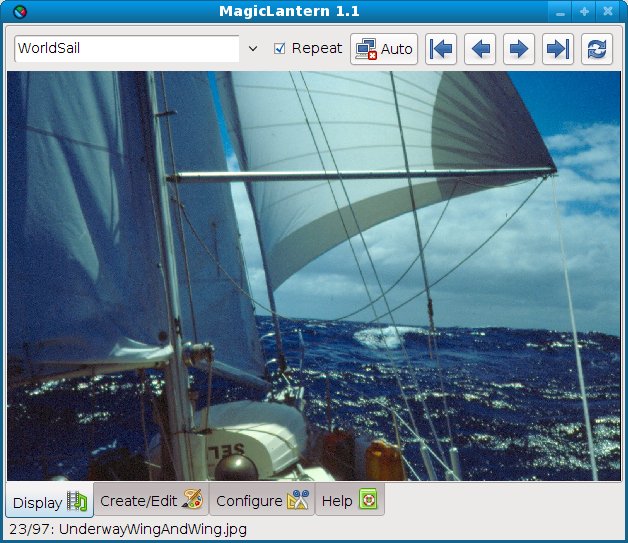

 Share This Page
Share This Page| Home | | Java | |  |  |  Share This Page Share This Page |
A multimedia presentation workshop.
Copyright © 2019, Paul Lutus — Message Page

MagicLantern is Copyright © 2019, Paul Lutus, and is released under the GPL. For an end user, release under the GPL essentially means MagicLantern is free (as in free speech, not as in free beer).
Because MagicLantern is written in Java, it can be run on virtually any platform — Windows, Linux, Macintosh, and others. This means if you create a multimedia presentation on one platform, it can be transferred and displayed on another, using the same program.
Here are some key MagicLantern features:
CareWare
If you are under 30 years of age, you can skip this section — it doesn't apply to you.
MagicLantern is officially and formally released under the GPL license, but it is also a CareWare release. Basically, this means in exchange for MagicLantern, you could be extra nice to someone, or stop whining about how hard your life is, at least for a while. And it's voluntary — I am not the police and CareWare is an idea, not a rule. Ideas aren't laws and there are no idea police — at least, not yet.My adult readers will now realize why I recommended that those under 30 skip this section. For those under 30, life is totally unfair, and if only life were just, they would be richer, smarter, and better-looking than they are. For those over 30, life is what is, we don't get to tell life how things are supposed to be, and our only job is to figure out how it works.
So ... just be nice. If you are already nice, be a tiny bit nicer, and you will have paid for MagicLantern. And if this idea annoys you, ignore it. MagicLantern is free.
Documentation
Click here to see a copy of the MagicLantern documentation that ships with the program. The online copy is missing a number of data items that are automatically filled in by the program when it runs. The help page displayed within MagicLantern is in every way better.
There are three MagicLantern download packages:
For Linux and other users who have downloaded the JAR archive, a bit of instruction about launching MagicLantern:
java -jar (full path to MagicLantern JAR archive)
java -Xmx1000m -jar (full path to MagicLantern JAR archive)
The Memory Issue
Because MagicLantern manages graphic images, I should explain something about their size. I have a typical semi-professional camera by Canon (a 40D). Its best images are 3,888 by 2,592 pixels in size and might occupy 4 megabytes when stored as compressed JPEG images. But when such an image is read by MagicLantern, it must be uncompressed, and an uncompressed full-color image has this size:
Size = width x height x 3 bytes per pixel
Size = 3,888 x 2,592 x 3 = 30,233,088 bytes
So each of my typical modern images require over 30 megabytes of memory while being processed. As it turns out, on Windows and without special instructions, the current Java runtime engine allocates itself just 66 megabytes. That is entirely inadequate and the Java runtime engine won't adjust its behavior without intervention.
For Linux and Macintosh, the remedy is shown above — create a shell script and edit the launch instruction like this:java -Xmx1000m -jar (full path to MagicLantern JAR archive)(I should add that this step is probably unnecessary, because the Linux Java runtime allocates itself enough memory by default, if there is enough memory on the system.)
For Windows, the runtime won't allocate sufficient memory, and the remedy is a bit more complex (as everything is on Windows) — you need to do this:
- Open a file browser.
- Select "Tools ... Folder Options ... File types"
- To save time, when confronted by the list of file types, type "j" at the keyboard. In most cases this will jump to "JAR", the file type of interest. If not, scroll down to get to the entry for "JAR".
- Click "Advanced", then "Edit".
- After the string "javaw.exe" and before the string "-jar", put this: "-Xmx1000m".
- The section of interest should now look like this: "(path)/javaw.exe -Xmx1000m -jar (path to MagicLantern)".
- Click "OK, "OK" and "Close".
MagicLantern has a memory indicator on its configuration panel, so one can easily verify the outcome for a fix like this.
| Home | | Java | |  |  |  Share This Page Share This Page |